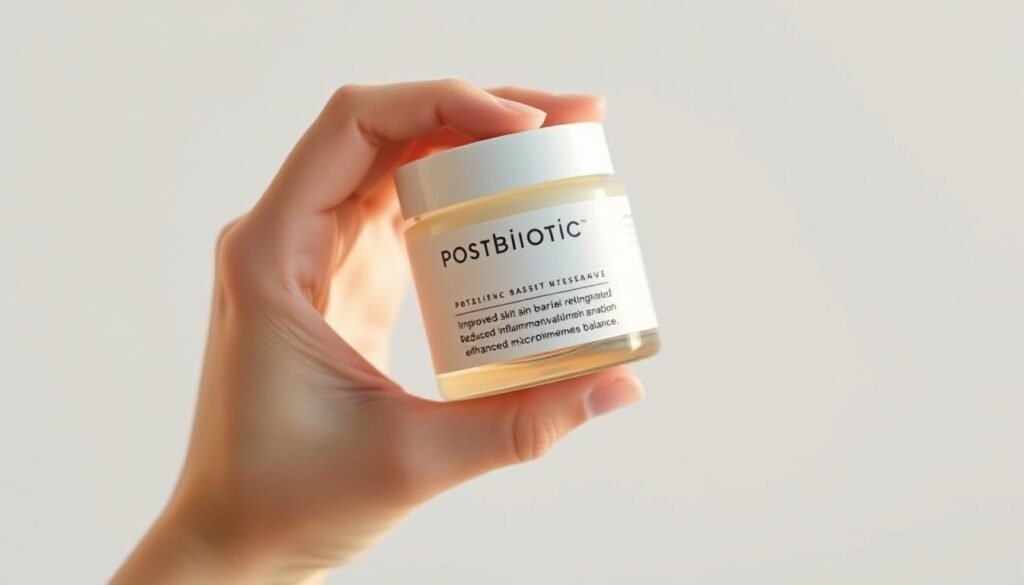Can a healthy gut lead to radiant, glowing skin? As we learn more about the link between gut health and skin, a new trend is rising in the skincare industry: postbiotic skincare.
The idea of using postbiotics for skin health is becoming popular. This is because more people are realizing how important gut-skin wellness is. But what are postbiotics, and how do they help our skin?
As scientists dig deeper into postbiotic skincare, it’s clear this new method could greatly improve our skin’s health.
Key Takeaways
- Postbiotics are emerging as a key trend in the skincare industry.
- The gut-skin connection is driving demand for postbiotic skincare products.
- Research is uncovering the potential benefits of postbiotics for skin health.
- Postbiotic skincare is poised to revolutionize the beauty industry.
- Innovative products leveraging postbiotics are on the rise.
What Are Postbiotics and Their Role in Skincare?
Postbiotic skincare is a new area in skin care, linked to gut health and skin wellness. It’s key to know what postbiotics are and how they affect skin conditions.
Understanding Postbiotics
Postbiotics are non-living parts of microbes made when probiotics ferment. They help skin health by strengthening the skin barrier, lowering inflammation, and keeping the microbiome balanced.
Using postbiotics in skincare is based on microbiology. It shows the skin and gut are connected. Skincare products with postbiotics can tackle many skin problems without live probiotics.
The Science Behind Gut-Skin Connection
The gut and skin are linked, with gut health affecting skin. Studies link an unbalanced gut to skin issues like acne, rosacea, and eczema.
Postbiotics help by:
- Modulating the immune response to reduce inflammation
- Strengthening the skin barrier to prevent moisture loss and protect against environmental stressors
- Regulating the skin’s pH to create an unfavorable environment for pathogenic microbes
Knowing about postbiotics and their role in skincare helps people choose better routines. This can lead to healthier, more resilient skin.
The Benefits of Postbiotic Skincare Products
Postbiotic skincare products offer many benefits. They improve the skin’s barrier and reduce inflammation. They also help keep the skin’s microbiome balanced, which is key for healthy skin.
Enhancing Skin Barrier Function
These products are great for strengthening the skin’s natural barrier. They help keep moisture in and protect against environmental stress. This makes the skin healthier and more resilient.
Reducing Inflammation and Irritation
Postbiotic skincare is also good at reducing inflammation and irritation. They have anti-inflammatory properties that soothe the skin. This makes them perfect for sensitive skin or conditions like acne or rosacea.
Promoting a Balanced Microbiome
A balanced skin microbiome is vital for healthy skin. Postbiotic skincare products support good bacteria and stop bad bacteria from growing. This balance helps prevent issues like acne, redness, and irritation.
Adding postbiotic skincare to your routine can greatly improve your skin’s health and look. They enhance the skin barrier, reduce inflammation, and balance the microbiome. This offers a complete skincare solution.
How Gut Health Affects Your Skin
Research shows gut health is key to having healthy, strong skin. The connection between our gut and skin is complex. Studies reveal that an imbalance in gut bacteria can cause skin problems.
The Link Between Gut Flora and Skin Conditions
The gut microbiome affects our skin in many ways. It controls our immune system and makes certain compounds. An imbalance in gut bacteria, or dysbiosis, is linked to skin issues like acne, psoriasis, and eczema.
In acne, an imbalance can cause more oil and inflammation. This makes acne worse. For psoriasis, an imbalance in gut bacteria can start an immune response that leads to skin lesions.
| Skin Condition | Gut Microbiome Impact |
|---|---|
| Acne | Increased sebum production and inflammation due to dysbiosis |
| Psoriasis | Abnormal immune response triggered by gut bacteria imbalance |
| Eczema | Impaired skin barrier function associated with gut microbiome dysbiosis |
Signs of Poor Gut Health on Your Skin
Poor gut health shows up on our skin in different ways. These include:
- Dull, lackluster complexion
- Increased sensitivity and irritation
- Acne and other inflammatory skin conditions
- Premature aging signs, such as fine lines and wrinkles
Spotting these signs is the first step to fixing gut health issues. This can lead to better skin health. Using postbiotic skincare products can help.
Popular Postbiotic Ingredients in Skincare
Research shows a strong connection between gut health and skin health. Postbiotic ingredients are now key in skincare. They are backed by studies on their benefits for the skin.
Common Types of Postbiotics Used
Skincare products often include Lactobacillus and Bifidobacterium derivatives. These are known for improving the skin barrier and reducing inflammation.
- Lactobacillus Ferment: Known for its soothing and anti-inflammatory properties.
- Bifida Ferment Lysate: Helps in improving skin elasticity and hydration.
- Saccharomyces Ferment: Enhances skin barrier function and provides antioxidant benefits.
How These Ingredients Work Together
These postbiotic ingredients work together to balance the skin microbiome. This teamwork is key to getting the most out of postbiotic skincare. It leads to better skin hydration, less irritation, and overall better skin health.
Adding postbiotic serums to your skincare routine can be very helpful. These serums give a strong dose of postbiotics to the skin. They help support the skin’s natural barrier and promote a healthier microbiome.
Knowing about the different postbiotics and how they work together helps in choosing the right skincare. This way, you can use postbiotics to get the best skin health.
Introducing Postbiotic Serums to Your Routine
Postbiotic serums are a great choice for those looking to improve their skincare. They are based on the connection between gut health and skin wellness. Adding products that support this balance is key.
What to Look for in a Postbiotic Serum
When picking a postbiotic serum, look for clinically-tested postbiotic ingredients. These ingredients help support skin health. They may include fermented extracts or other compounds that boost skin barrier and reduce inflammation.
Also, choose serums with complementary ingredients like hyaluronic acid or niacinamide. These add hydration and improve skin elasticity, making the serum more effective.
How to Apply Postbiotic Serums Effectively
To get the most out of a postbiotic serum, apply it right. Start with a clean face. Then, put a few drops on your face and neck, massaging it in until it’s fully absorbed.
Next, apply a moisturizer to keep the serum’s benefits in. This helps your skin’s barrier function. Being consistent is important for the best results.
The Difference Between Probiotics and Postbiotics
As more people focus on gut-skin wellness, it’s key to know the difference between probiotics and postbiotics. Probiotics are live bacteria, while postbiotics are their non-live parts. Knowing this helps you choose the right skincare.
Understanding Live vs. Non-Live Ingredients
Probiotics are live bacteria that help your health when used right. Postbiotics, on the other hand, are what’s left after bacteria ferment. The big difference is that probiotics need to stay alive, while postbiotics don’t.
Probiotics are hard to keep alive in skincare products. But postbiotics are easy to mix into products. They don’t need special care.

Key Benefits of Postbiotics Over Probiotics
Postbiotics have big advantages over probiotics in skincare. They last longer and are easier to use in products. They also help your skin in special ways, like making it stronger and less inflamed.
| Characteristics | Probiotics | Postbiotics |
|---|---|---|
| Viability | Live microorganisms | Non-live metabolites or dead microbial cells |
| Stability | Requires specific conditions to survive | More stable and easier to formulate |
| Benefits | Confers health benefits through colonization | Provides targeted benefits like enhancing skin barrier and reducing inflammation |
The science behind postbiotic skincare is about keeping your skin’s microbiome balanced. It helps your skin’s natural barrier. Knowing the difference between probiotics and postbiotics helps you pick better skincare.
Incorporating Postbiotics for Holistic Wellness
To get the most from postbiotic beauty products, you need a whole-body approach. This means taking care of your skin and eating right. It’s about making your inside and outside health work together.
Finding Balance in Your Skincare and Diet
Eating foods high in fiber, fruits, and veggies helps your gut bacteria grow. This boosts the postbiotic skincare benefits for gut health. Adding fermented foods like yogurt, kimchi, and sauerkraut to your meals can also help your gut.
For your skin, using products with postbiotics keeps it healthy. It fights inflammation and keeps your skin’s balance.
Daily Habits to Support Skin Health
Building daily habits for skin health is key to overall wellness. This includes:
- Keeping a regular skincare routine that cleanses, moisturizes, and protects from the sun.
- Drinking lots of water all day.
- Eating a diet full of antioxidants, vitamins, and minerals.
- Getting enough sleep and managing stress with meditation or yoga.
By using postbiotic beauty products and eating well, you support your skin and health. This whole-body approach can make you healthier and more resilient.
Postbiotic Skincare for Different Skin Types
Postbiotic skincare works well for many skin types, including oily and sensitive skin. It helps meet the unique needs of each skin type. This way, people can get healthier, more balanced skin.
Tailoring Products for Oily Skin
Postbiotic skincare is great for oily skin. It tackles issues like too much oil and big pores. Postbiotic ingredients balance the skin’s microbiome. This makes the skin look less oily and more matte.
- Choose lightweight, oil-free postbiotic products to avoid clogged pores.
- Look for products with Lactobacillus or other balancing strains for oily skin.
Solutions for Dry or Sensitive Skin
Dry or sensitive skin needs hydration and soothing. Postbiotic skincare deeply moisturizes and fixes the skin’s barrier. It’s perfect for dry or sensitive skin.
For dry or sensitive skin, pick products with soothing ingredients like aloe vera or hyaluronic acid. These add to the postbiotics’ benefits.
Key benefits for dry or sensitive skin include:
- Enhanced hydration
- Reduced irritation
- Improved skin elasticity
By choosing the right postbiotic skincare for your skin type, you can get the most out of these products. You’ll have healthier, more resilient skin.
Consumer Trends in Postbiotic Skincare
Postbiotic skincare is becoming a big deal in the beauty world. People are learning how gut health affects their skin. This has made them want products that help with this connection.
Growing Popularity of Gut-Skin Products
More people want postbiotic skincare benefits like better skin barrier and less inflammation. They see postbiotics as a way to keep their skin microbiome balanced. This leads to healthier, more resilient skin.
Looking for postbiotic beauty products that are science-backed is what’s driving this trend. Brands are now making products that meet these high standards. This is why postbiotic skincare is taking up more space in the market.

Market Insights on Postbiotic Formulations
Market research shows a big move towards postbiotic skincare. Brands are making products with postbiotics in different forms, like serums and creams. This is because consumers want these products.
| Product Type | Key Ingredients | Benefits |
|---|---|---|
| Postbiotic Serums | Lactobacillus, Bifidobacterium | Enhances skin hydration, reduces fine lines |
| Postbiotic Creams | Postbiotic extracts, Hyaluronic Acid | Moisturizes, soothes irritated skin |
| Postbiotic Masks | Postbiotic filtrate, Glycerin | Intensely nourishes, rejuvenates skin |
The demand for postbiotic skincare is only going to grow. As people learn more about postbiotics for skin health, they’ll want these products. Brands that offer effective, science-backed products will be at the forefront of this trend.
Addressing Common Misconceptions About Postbiotics
Postbiotic skincare products have gained popularity, but myths surround them. It’s key to know the truth about their benefits for skin and gut health.
Myths vs. Facts
Many think postbiotics are just a skincare trend. But, postbiotic skincare science proves they offer real benefits. They improve skin health by enhancing the skin barrier and reducing inflammation.
Some believe postbiotics and probiotics are the same. But, they are not. Probiotics are live bacteria that help health. Postbiotics, on the other hand, are non-live compounds from probiotic fermentation. They offer benefits without the need for live cultures.
The Real Deal About Safety and Efficacy
Some worry about postbiotic skincare safety and effectiveness. But, research shows they are safe for the skin and beneficial for many skin types. It’s important to pick products with solid scientific backing and effective postbiotics.
Postbiotic skincare benefits for gut health are backed by studies. They can improve skin health by strengthening the skin barrier, reducing inflammation, and balancing the microbiome.
In summary, while there are myths about postbiotics, the facts are promising. Understanding postbiotic science and choosing the right products can unlock their benefits for skin and gut health.
DIY Skincare Recipes with Postbiotics
Postbiotic skincare isn’t just about buying products. It’s also about making your own. By adding postbiotics to homemade skincare, you can make it fit your needs perfectly.
Simple At-Home Options
Making DIY skincare with postbiotics is easy and fun. Here are a few simple recipes to try:
- Postbiotic Face Mask: Mix postbiotic powder with honey and yogurt. It’s a soothing face mask that nourishes and calms your skin.
- Postbiotic Serum: Mix postbiotic extract with your favorite facial oil. Apply it to your skin for better hydration and barrier support.
Combining Postbiotics with Other Skincare Ingredients
Postbiotics work well with other skincare ingredients. For example, adding them to hyaluronic acid boosts hydration. Mixing them with niacinamide reduces inflammation and improves skin elasticity.
| Skincare Ingredient | Benefit | Combination with Postbiotics |
|---|---|---|
| Hyaluronic Acid | Hydration | Amplifies moisturizing effects |
| Niacinamide | Reduces inflammation, improves elasticity | Enhances skin barrier function and reduces irritation |
| Vitamin C | Antioxidant properties | Boosts brightening and collagen production |
Try different combinations to make a postbiotic serum or product that meets your skin’s needs.
Future of Postbiotic Skincare
The skincare world is on the verge of a big change. Gut-skin postbiotics are leading the way. As scientists learn more about the gut-skin connection, we’re seeing more benefits in skincare.
Emerging Trends
New trends in postbiotic skincare are set to grow the industry. Companies are creating products that tackle skin issues and boost gut health. This change is because people want all-around wellness.
Industry Expectations
As we understand postbiotics better, we’ll see advanced skincare products. The future is in customized skincare that meets each person’s needs. It will use the power of postbiotics to improve skin health.



